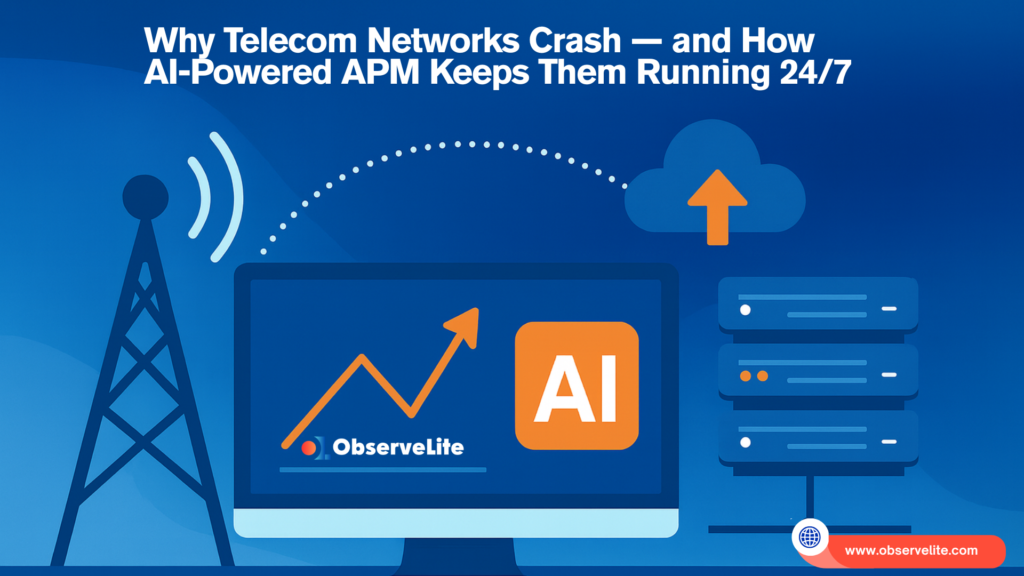Introduction
Telecom providers live in a world where downtime is simply not an option. Every dropped call, frozen video stream, or stalled payment comes at a cost — not just in money, but in customer trust. Yet even the most advanced networks crash. Hardware fails, software bugs creep in, traffic surges overwhelm capacity, and unexpected threats slip through.
This is where AI-powered APM for telecom networks changes the game. By combining predictive analytics, real-time monitoring, and automated root cause detection, it shifts telecom operations from firefighting outages to preventing them in the first place. In this blog, we’ll break down why networks fail, and how AI-powered APM ensures the always-on experience customers demand.
What Are the Main Causes of Telecom Network Crashes?
Even the biggest telecom players can’t escape downtime. The most common culprits include:
-
- Traffic overloads — Sudden spikes during live events or peak hours strain infrastructure.
-
- Hardware failures — Servers, switches, and cables all have breaking points.
-
- Software glitches — Bugs in new updates or patches can trigger cascading failures.
-
- Cyberattacks — DDoS attacks and breaches can bring networks down.
-
- Human error — Misconfigurations and operational mistakes remain a top cause of outages.
On their own, each of these risks is manageable. Together, they form a complex web of potential failure points.
How Does AI-Powered Predictive Analysis Prevent Telecom Outages?
Traditional monitoring tools only alert operators after something breaks. AI-powered APM takes a proactive approach by:
-
- Studying historical performance data to forecast potential overloads.
-
- Detecting early warning signs like rising latency or packet loss.
-
- Simulating “what if” scenarios to prepare for traffic surges.
-
- Recommending adjustments before an outage occurs.
This predictive power turns downtime from a surprise into something operators can anticipate and stop before it happens.
How Does AI-Powered APM Differ from Traditional Monitoring Tools?
Traditional monitoring = reactive. It tells you what’s broken.
AI-powered APM = proactive. It explains why something might break and how to fix it before users notice.
Key differences include:
-
- Root-cause analysis: AI doesn’t just flag errors; it pinpoints where they started.
-
- Automation: Issues can be auto-resolved without human intervention.
-
- User experience monitoring: It tracks not just uptime, but whether customers are actually experiencing smooth service.
Can AI Really Predict and Prevent Telecom Network Failures?
Skepticism is natural. But in practice, AI models have already shown they can:
-
- Spot unusual network behaviors hours before they escalate.
-
- Identify risky trends that human teams miss in massive datasets.
-
- Trigger self-healing mechanisms that reroute traffic or restart processes.
Instead of waiting for a system crash, telecom teams can now steer around it.
What Role Does APM Play in Ensuring 5G Reliability?
5G networks are faster, denser, and more complex — which means more chances for things to go wrong. AI-powered APM ensures 5G reliability by:
-
- Managing the interplay of small cells and massive MIMO infrastructure.
-
- Monitoring real-time bandwidth allocation.
-
- Adapting quickly as users move between high-demand zones.
In short, APM becomes the nervous system keeping 5G agile and stable.
How Do Telecom Providers Benefit from Predictive Analytics in APM?
For providers, benefits go beyond uptime:
-
- Reduced operational costs: Fewer emergency fixes mean lower support overhead.
-
- Customer loyalty: Consistent uptime strengthens trust.
-
- Faster innovation: Less time fighting fires, more time scaling services.
-
- Regulatory compliance: Meeting SLAs and uptime commitments is easier with predictive control.
How Does AI-Based Root Cause Analysis Speed Up Troubleshooting?
Outages used to take hours or even days to diagnose. AI-powered root cause analysis shrinks that to minutes by:
-
- Mapping failure points across the network.
-
- Linking symptoms (e.g., dropped calls) to the underlying issue (e.g., switch overload).
-
- Providing engineers with a ranked list of probable causes.
This reduces downtime dramatically — and in many cases, prevents it altogether.
What Future Challenges Will AI Help Telecom Companies Address?
AI-powered APM isn’t just about solving today’s crashes; it’s preparing telecom providers for what’s next:
-
- Managing the massive complexity of 5G and beyond.
-
- Scaling infrastructure for billions of IoT devices.
-
- Handling unpredictable demand spikes from virtual reality, metaverse platforms, or global events.
-
- Strengthening defenses against increasingly sophisticated cyberattacks.
FAQ Section
Q1: What are the most common causes of telecom network outages?
Traffic overloads, hardware breakdowns, software errors, cyberattacks, and human mistakes are the main triggers.
Q2: How does predictive analytics improve telecom network reliability?
By analyzing historical data and spotting early warning signs, predictive models help operators fix issues before they lead to downtime.
Q3: Can AI-powered APM reduce costs for telecom providers?
Yes. By preventing outages and automating root cause analysis, providers spend less on emergency fixes and manual troubleshooting.
Q4: What role does APM play in ensuring 5G reliability?
It monitors bandwidth allocation and manages the dense infrastructure behind 5G to keep service smooth.
Q5: How does AI-based monitoring improve customer experience?
AI tracks not only network uptime but also real user performance, ensuring customers actually enjoy consistent, high-quality service.
Conclusion
Telecom networks will always face risks — from surging traffic to cyber threats. What’s changing is how providers respond. With AI-powered APM for telecom networks, downtime is no longer inevitable. Predictive analytics, automated root cause analysis, and real-time monitoring work together to keep networks stable, customers satisfied, and businesses competitive.
For providers under pressure to deliver 24/7 uptime, AI-powered APM isn’t just a tool — it’s the safety net that keeps modern telecom running.


